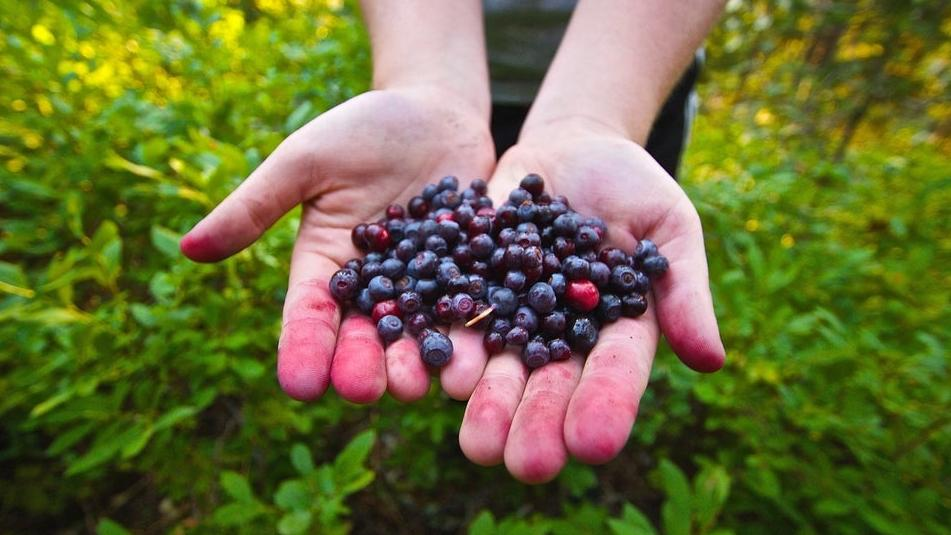The Humble Huckleberry Is Summer's Most Underrated Fruit
Unbeknownst to many, this berry native to the Pacific Northwest packs a punch.
Summers in Oregon are ripe with a wide variety of fruits. It fills me with glee to go to the supermarket and see more than the standard trio of apples, oranges, and bananas on rotation. I spend extra time at the farmers market stands admiring each fruit, touching the skin, marveling at the color, texture, and sweet juicy insides, excited to bring them home. From melons to stone fruits, I thought I'd seen it all.
Only recently did I stumble upon a berry that looked suspiciously like a cross between a blueberry and a grape. At first, I thought it was a crossbreed, the hybrid result of agricultural science. (Oregon is, in fact, known for its one-of-a-kind berry breeding program). Turns out, it was the huckleberry.
What is a huckleberry?
Huckleberries are generally deep plum, itty bitty things the size of a pea, sometimes a bit smaller. They taste like a mix between cranberries and blueberries—not exactly sweet but not completely tart either. While native to the Pacific Northwest, they're not as ubiquitous as their berry cousins. I've lived in Oregon for many years, and yet I'd never seen them before.
So I set out to learn why. I found that the answer lies deep in the mountains.
Huckleberries are also called "wild huckleberries" and "Western huckleberries." But don't let the name fool you. The west coast boasts at least seven species of wild huckleberries, which are in fact native blueberries, according to Bernardine Strik, professor of horticulture at Oregon State University. They belong to the genus Vaccinium, the same as commercially sold blueberries.
Officially the state fruit of Idaho, huckleberries are a source of nourishment for bears and humans alike. They're high in iron and provide a good source of potassium and vitamin C. Oregonians know that the wet, cold climate of the state makes for a dull, gray day. But these are the perfect conditions for huckleberries, which thrive in high elevations, coniferous forests, and cool temperatures.
In Oregon, they grow in the Cascade Mountain range, from Mount Hood all the way to Crater Lake in southern Oregon. You can also find them in Washington, Idaho, Montana, and western Wyoming. Their shrubs can often be found in the underbrush or mountainous regions, and even along lakes and streams at higher elevations.
Huckleberries’ cultural role in the west
These little fruits provide more than just nutritional value for humans and bears. Native American tribes of the Pacific Northwest were the first to harvest huckleberries for medicinal purposes and as a food source. Over time, the ritual of picking, harvesting, and using huckleberries for a variety of purposes became a significant part of their culture.
For example, the Yakama tribe of southern Washington performs a process of controlled burns every few years. Each time, they burn around 5,000 to 6,000 acres of land. Think of it as a pruning mechanism to reduce overgrowth. "For many generations," The Columbian writes, "the tribe has burned these forests regularly to open the canopy and assure a bountiful huckleberry harvest."
Huckleberries are considered a sacred food to the Indigenous peoples, especially the Yakama tribe. Through a special agreement between the tribe and the U.S. Forest Service, the Sawtooth Huckleberry Fields in the Gifford Pinchot National Forest became designated as a cultural site, where the burning still occurs today.
Where to get huckleberries
Finding huckleberries is like having a long-lost brother show up at your door: You know they exist, but it's still a surprise to see them. Because they have a short ripe season, coupled with the fact that they produce little fruit when they are ripe, huckleberries have become something of a treasure hunt for outdoor enthusiasts. For this reason, there is a strong culture of foraging on the west coast.
If you live in Oregon or Idaho and aren't afraid of the distance, you can take a drive during the summer to the Gifford Pinchot National Forest or the Idaho Panhandle National Forests, where huckleberries are in picking season from mid-August to mid-September. The berries are free to pick so long as it is for personal use.
But if foraging isn't your thing, you can always buy huckleberries from farmers markets. Be ready to shell out big bucks for these guys. On Facebook, I found a local farmer selling them recently for $26 per pound. Ouch.
However, Made in Oregon has a unique collection of jams, candies, syrups, and other items made from harvested wild huckleberries themselves. They make great gifts, and at the very least, you can inhale the delicious scent of huckleberries and get a kick out of imagining yourself as a harvester of wild, edible fruit whose rarity makes it all the more treasured.
